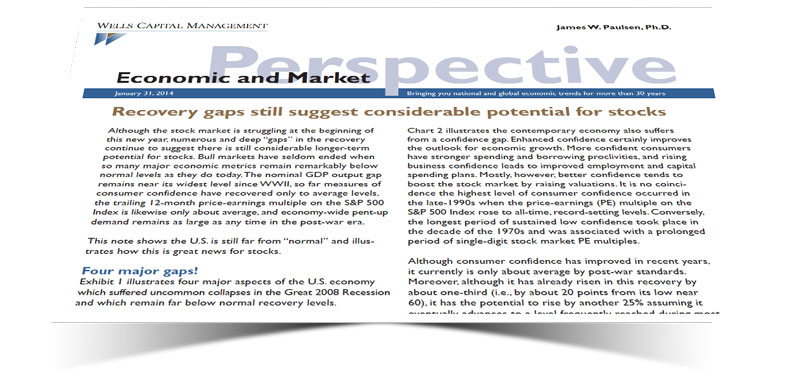Recovery gaps still suggest considerable potential for stocks
by James Paulsen, Chief Investment Strategist, Wells Capital Management
Although the stock market is struggling at the beginning of this new year, numerous and deep “gaps” in the recovery continue to suggest there is still considerable longer-term potential for stocks. Bull markets have seldom ended when so many major economic metrics remain remarkably below normal levels as they do today. The nominal GDP output gap remains near its widest level since WWII, so far measures of consumer confidence have recovered only to average levels, the trailing 12-month price-earnings multiple on the S&P 500 Index is likewise only about average, and economy-wide pent-up demand remains as large as any time in the post-war era. This note shows the U.S. is still far from “normal” and illustrates how this is great news for stocks.
Four major gaps!
Exhibit 1 illustrates four major aspects of the U.S. economy which suffered uncommon collapses in the Great 2008 Recession and which remain far below normal recovery levels. Chart 1 shows the U.S. output gap—the percent difference between the current level of nominal GDP and the level of potential GDP (that which could be achieved at full employment with existing technology and normal productivity). In 2009, the output gap widened to almost 5%, the worst post-war gap outside of a slightly wider gap in the early-1980s.
Subsequently, it has improved but remains almost 2% below potential GDP and almost 4.7% below its average 2% premium to potential output since 1950. Improvement in the output gap from levels below potential GDP is typically very good for stocks. Due to the excess capacity implied by the output gap, real economic growth is often enhanced without significant inflationary consequences. Even though the output gap has improved in this recovery, it is currently at or below most recession bottoms of the post-war era implying the economy still has considerable room to grow in a noninflationary, stock market friendly fashion.
Moreover, investors should take comfort in the fact that a recession has never resulted in post-war history before the output gap was closed. While a persistent and outsized output gap may be an economic, political, and cultural tragedy, it is indeed welcoming for the stock market. It suggests a recession is still some ways off and implies the recovery is likely to follow a noninflationary growth path until this gap is closed.
Chart 2 illustrates the contemporary economy also suffers from a confidence gap. Enhanced confidence certainly improves the outlook for economic growth. More confident consumers have stronger spending and borrowing proclivities, and rising business confidence leads to improved employment and capital spending plans. Mostly, however, better confidence tends to boost the stock market by raising valuations. It is no coincidence the highest level of consumer confidence occurred in the late-1990s when the price-earnings (PE) multiple on the S&P 500 Index rose to all-time, record-setting levels. Conversely, the longest period of sustained low confidence took place in the decade of the 1970s and was associated with a prolonged period of single-digit stock market PE multiples.
Although consumer confidence has improved in recent years, it currently is only about average by post-war standards. Moreover, although it has already risen in this recovery by about one-third (i.e., by about 20 points from its low near 60), it has the potential to rise by another 25% assuming it eventually advances to a level frequently reached during most post-war recoveries (i.e., back close to about 100).
As shown in Chart 2, consumer confidence collapsed to a similar extent during both the 1975 and the 1980-1982 recessions. However, unlike the contemporary era, in both the late-1970s recovery and again in the 1980s recovery, confidence improved quickly. In the 1970s, within a couple years the Consumer Confidence Index had recovered to above 90.
Similarly, in the 1980s, confidence exploded higher as soon as the recovery began and was back near post-war recovery highs of about 100 within three years. By contrast, even though the current recovery is 4.5 years old, confidence still has considerable upside potential. That is, unlike earlier recoveries, today the stock market can still benefit from a further closing of the confidence gap.
Chart 3 illustrates stock market valuations also still have significant potential for improvement. While the stock market has rallied by about 160% from its crisis low, the trailing 12-month PE multiple is currently only slightly above its postwar average. As illustrated in Chart 3, investors can currently buy the stock market at the same valuation level as in 1958, 1985, or 1994, all of which subsequently produced healthy investment results primarily because PE multiples advanced.
Of course, PE multiples could also decline in the next few years as they did when inflation raged out of control in the 1970s. However, a “valuation gap” still exists in this recovery and if PE multiples do eventually reach past post-war recovery highs (e.g., around 20 times earnings prior to 1990 and perhaps more like 25 times earnings in the last 25 years), investors who stay the course until this gap is closed will be well rewarded.
Continue reading or download the complete report below:
James Paulsen: Investmnet Outlook February 2014
Copyright © Wells Capital Management















